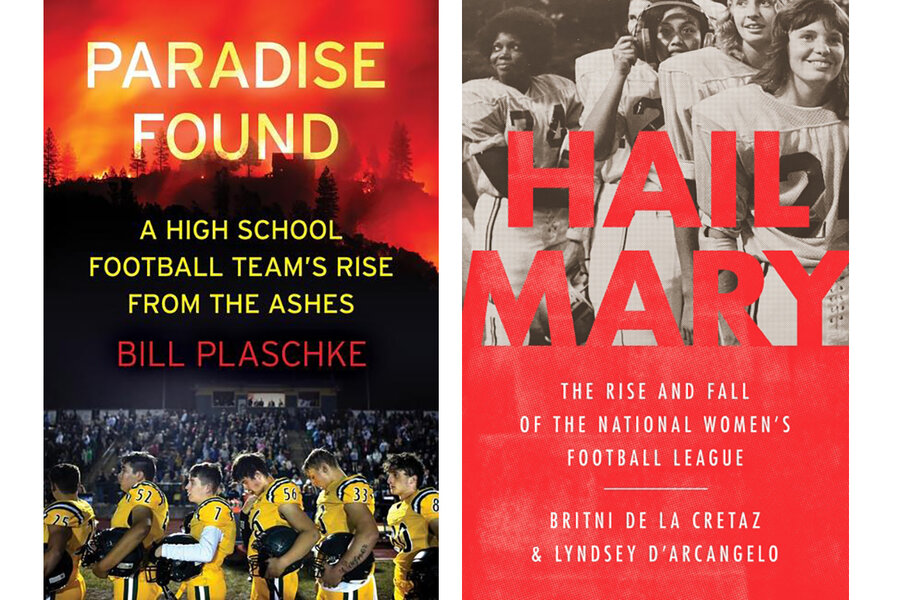Two football books celebrate unity – on and off the field
Loading...
With the National Football League heading into the wild card games next weekend, and the college football championship scheduled for Monday, powerhouse teams dominate viewers’ imaginations. But the heart and soul of football doesn’t always play out in college or pro settings. And it doesn’t have to exclude women. Two recent books show how the game can unite a ravaged community and become a vehicle for equality.
A town burned, a team united
On Nov. 8, 2018, Paradise High School football coach Rick Prinz was texting his players about delaying practice; minutes later, the Northern California town’s residents were running for their lives. The Camp fire decimated Paradise, killing more than 80 people, and destroying 12,000 homes. The conflagration also wrecked the Paradise Bobcats’ shot at the playoffs. With the town in ashes (except, remarkably, for the high school’s football field), there was little hope of playing the 2019 season, either. Still, as Bill Plaschke, sports columnist for The Los Angeles Times, writes in “Paradise Found: A High School Football Team’s Rise from the Ashes,” the Bobcats’ pulled off a remarkable comeback, bringing their town along with them.
When football games resumed 10 months after the fire, the Friday night lights had never meant so much to the community. It gave the people of Paradise a meeting place, a common cause, and a much-needed sense of normalcy, Plaschke writes. Playing football was also beneficial for the young men, a way of expressing their grief and taking back some control over their lives, even if they were also painfully aware of how much the people of Paradise were counting on them. The players were able to rise to the occasion, notching an undefeated 10-game season, stopped only by a heartbreaking loss in the championship.
Plaschke’s focus on the human side of this football story is a winning choice. Though there isn’t as much on-the-field action as one would expect, and the formula for each chapter can get a bit repetitive, there is emotional power behind the words of “Paradise Found.” It’s a gut-wrenching and inspiring tale of the healing power of sports.
Women of the gridiron
Sports can also empower female athletes and subvert popular expectations around what women can do. For example, the notion that women aren’t tough enough to play football. In “Hail Mary: The Rise and Fall of the National Women’s Football League,” sportswriters Britni de la Cretaz and Lyndsey D’Arcangelo delve into the history of the largely forgotten women’s football league.
The story of women in football started long before the NWFL’s official founding in September 1974. It dates back to the invention of the sport in the late 19th century, when women took up football with gusto equal to that of men. But by the time the league came about, sexist ideas about women were deeply entrenched in American society. Women playing football were ridiculed and told it was too rough a sport for their delicate bodies, and besides, their game would never be as entertaining to watch as the men’s.
But the women of the league proved the naysayers wrong. They were ferocious athletes, as competitive and hard-hitting as their male counterparts. They played the game because they loved it, because it helped them celebrate the power of their bodies and accept themselves and their teammates for who they were. The players in the NWFL didn’t aim to become poster children for the women’s liberation movement or to make a political statement, but that didn’t change the fact that they were carving out a space for women in a male-dominated field.
Sadly, the women’s efforts were undermined by the league’s lack of organization, popular support, and crucially, money. Convincing sponsors that women’s sports were worth backing was a nearly unsurmountable obstacle. Not many of the approximately 19 teams lasted into the 1980s.
Though the league’s lifespan was short, the impressive women of the NWFL took on a so-called man’s sport and excelled, and in “Hail Mary,” readers come to know the players and the teams they called family. The authors strike a good balance between on-the-field and off-the-field action, making the reading as riveting as it is informative. “Hail Mary” is a necessary and comprehensive history of a league far ahead of its time.








